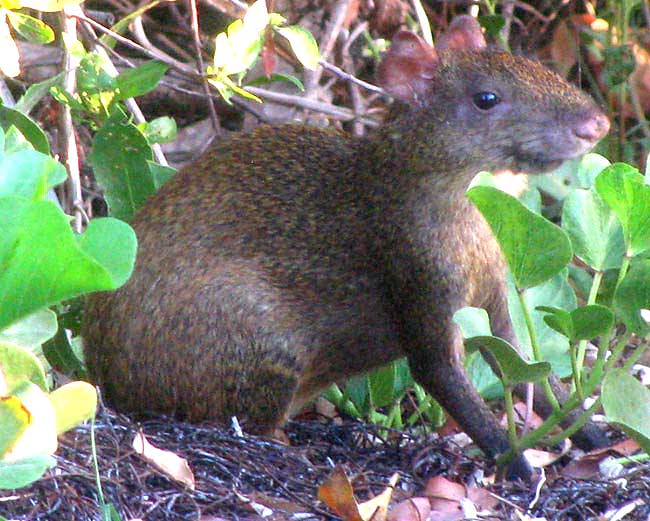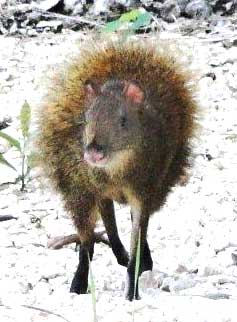Excerpts from Jim Conrad's
Naturalist Newsletter

from the June 6, 2011 Newsletter issued from written at Mayan Beach Garden Inn 20 kms north of Mahahual; Caribbean coastal beach and mangroves, ~N18.89°, ~W87.64°, Quintana Roo state, MÉXICO
AGOUTIS
On an average day at least once I see what's shown above. That's a Central American Agouti, DASYPROCTA PUNCTATA, a rodent member of the mostly South American Agouti Family, the Dasyproctidae. The species is distributed from southern Mexico south through central South America.
The picture shows a small one about the size of a rabbit nosing around our compost heap, as usually it does early each morning. Adult agoutis are as big as small pigs and from a distance look just like pigs with rodent heads. Despite their rabbity manner of sitting they run like pigs, too, stiff-legged and fast, their bodies high off the ground, not hopping. However, if you scare one by quietly biking up behind him on a calm morning, he can make an amazing leap with those rabbity back legs -- more than six feet from a standing position.
Agoutis bear five toes on their front feet and three on their hind feet. They walk on their toes, not flat- footed like many rodents. The tracks I've seen show only three toes on each foot, as shown below:

Getting a good picture of an agouti has been hard because either they're grazing in morning light too dim for a sharp picture, or else in broad daylight they're zipping across roads too fast to get a camera ready. Judging from the daily collection of new prints in dust along the road, there are lots of them. When I hear animals crashing through the underbrush as my bike glides by, I'll bet that most of noise is caused by agoutis. Agoutis are diurnal -- active during the day. Mostly they eat fallen fruit, and one way to find them in dense vegetation is by listening for their gnawing on hard seeds.
One thing I'd like to photograph is their courtship ritual in which the male sprays urine on the female, who then goes into a "frenzy dance," leading up to mating. Agouti young need about 487 days to reach maturity, which seems a long time for a rodent, and the average agouti lifespan is nearly 14 years, which also seems long for a rodent.
SPECIAL NOTE: December 21, 2012
Ashley Smith in the Yucatan sends the photograph shown below:

Agoutis are known to raise the hairs on their rear ends, making themselves look larger, when threatened, and here's proof of it.